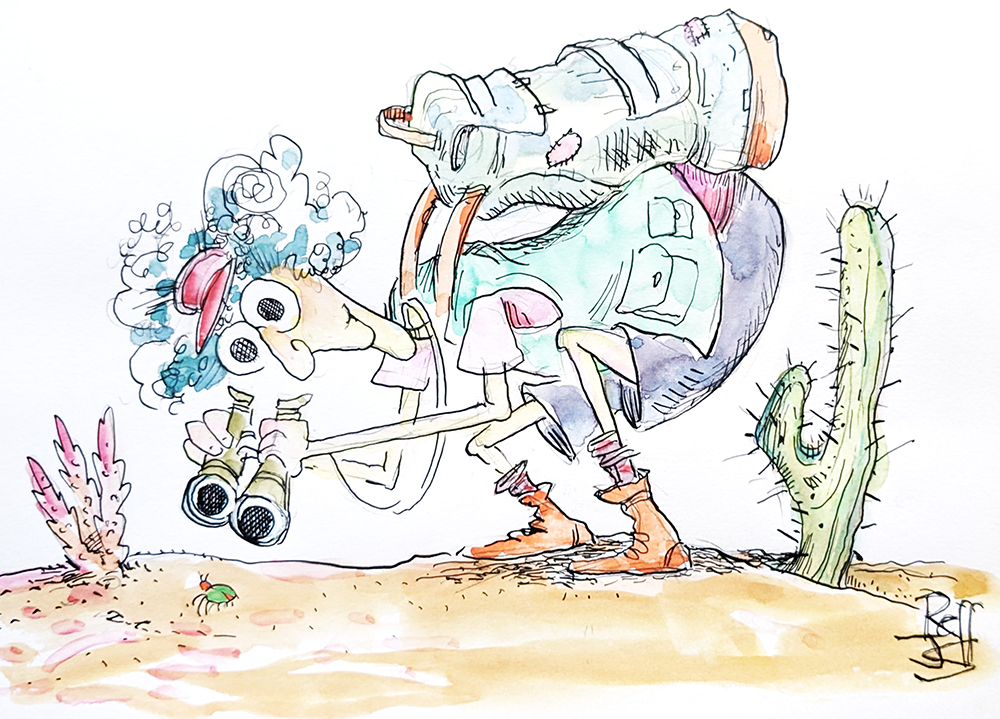Coop Scoop Blog
Ticked Off!
by Colie Collen
Illustration by Jeffery Wright-Sedam
Spring is here and it’s TICK TIME, everybody. We’re all familiar with the little (tiny!) buggers and the threat they pose, but small measures can go a long way in preventing Lyme and other tick-borne illnesses. Here’s some necessary info from the New York Department of Health. (Please see the website at the bottom of this article for more comprehensive info from DOH.)
Lyme disease is a bacterial infection caused by the bite of an infected deer tick. Not all deer ticks carry Lyme, but many do, and the tick population has increased dramatically in the last decade. In New York, we have deer, dog, and Lone Star ticks. Only deer ticks carry Lyme, but the other species can also cause less-common infections; it’s always good to protect ourselves.
A deer tick is a tiny arachnid that lives in shady, moist areas close to the ground. They cannot jump or fly, and only end up on humans when we brush up directly against grasses, shrubs, and brush. Then they climb to a protected area (groin, armpit, etc) and bite. Amazingly, they inject a numbing chemical with their bite, which makes humans unaware of having been bitten, thereby increasing the tick’s chance of a good meal and the human’s chance of getting Lyme disease.

The best course of protection against ticks & Lyme is preventing contact in the first place. Here are some tips:
- Wear light-colored clothing with a tight weave to spot ticks easily.
- Wear enclosed shoes, long pants and a long-sleeved shirt. Tuck pant legs into socks or boots and shirt into pants.
- Check clothes and any exposed skin frequently for ticks while outdoors.
- Consider using insect repellent.
- Stay on cleared, well-traveled trails. Walk in the center of trails. Avoid dense woods and bushy areas.
- Avoid sitting directly on the ground or on stone walls.
- Keep long hair tied back, especially when gardening.
- Bathe or shower as soon as possible after going indoors (preferably within two hours) to wash off and more easily find ticks that may be on you.
- Do a final, full-body tick check at the end of the day (also check children and pets), and remove ticks promptly.
If you do have a tick embedded, don’t panic. Congratulate yourself for encountering the out of doors! Here’s how to remove it:
- Use a pair of pointed tweezers to grasp the tick by the head or mouth parts right where they enter the skin. DO NOT grasp the tick by the body.
- Pull firmly and steadily outward. DO NOT jerk or twist the tick.
- Place the tick in a small container of rubbing alcohol to kill it.
- Clean the bite wound with rubbing alcohol or hydrogen peroxide.
- Monitor the site of the bite for the next 30 days for the appearance of a rash. If you develop a rash or flu-like symptoms, contact your health care provider immediately.
Now that it’s off of you, watch yourself. Symptoms of potential Lyme include:
- A rash at or near the site of the bite, circular and red, sometimes known as a “bulls-eye rash.” It can appear between 3 days and one month after the bite, but it usually not painful or itchy.
- A fever is sometimes present, as is muscle stiffness, joint pain, and general fatigue
- As Lyme disease progresses, fatigue can worsen, and tingling in the arms and legs
- If left entirely untreated, severe symptoms can include severe headaches, painful arthritis, swelling of the joints, and heart and central nervous system problems.
If symptoms of Lyme are caught early, and the patient is treated with antibiotics, a speedy recovery is likely. Untreated Lyme, however, can become much more difficult to manage.
Good luck out there, everyone! Stay safe and have fun.
https://www.health.ny.gov/diseases/communicable/lyme/fact_sheet.htm
